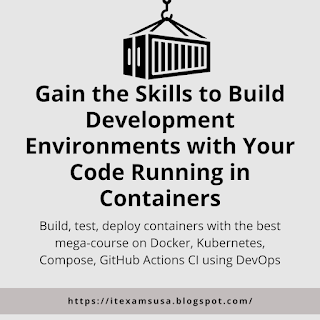Gain the Skills to Build Development Environments with Your Code Running in Containers
Embracing Containerization for Development Efficiency
Introduction
In today's fast-paced world of software development, the use of containers has become increasingly prevalent. Containers offer a consistent, efficient, and portable way to package applications and their dependencies, making them an indispensable tool for developers. In this comprehensive guide, we'll embark on a journey to explore the world of containerization and discover how you can build development environments where your code runs seamlessly within containers. By the end of this journey, you'll have gained the skills needed to enhance your software development workflows and productivity significantly.
Chapter 1: Understanding the Container Revolution
Unveiling the Container Concept: Containers demystified - What are containers, and how do they differ from traditional virtual machines (VMs)? We'll delve deep into the core concepts behind containerization.
# Example code: Running a simple container
docker run -d -p 8080:80 nginx
Why Containers Are a Game-Changer: Explore the myriad advantages of containers, from resource efficiency to improved collaboration among development and operations teams. Understand why containers have become the de facto choice for modern application deployment.
Chapter 2: Getting Started with Docker
Meet Docker, Your Containerization Companion: Dive into Docker, the leading container platform that has revolutionized software packaging and distribution. Learn how to install Docker on your system and get acquainted with its essential components.
# Example code: Pulling a Docker image
docker pull ubuntu:20.04
Building Your First Container: Get hands-on experience creating your first Docker container. Follow step-by-step instructions and examples to ensure you're up and running in no time.
# Example Dockerfile
FROM ubuntu:20.04
RUN apt-get update && apt-get install -y nginx
CMD ["nginx", "-g", "daemon off;"]
Containerizing Your Applications: Discover how to package your applications and their dependencies into Docker containers. We'll provide detailed guidance and best practices.
# Dockerfile for a Node.js application
FROM node:14
WORKDIR /app
COPY package*.json ./
RUN npm install
COPY . .
CMD ["node", "app.js"]
Chapter 3: Managing Containers Like a Pro
Container Orchestration with Kubernetes: Explore Kubernetes, the industry-standard container orchestration platform. We'll introduce Kubernetes concepts and guide you in setting up your cluster.
# Example code: Creating a Kubernetes deployment
kubectl create deployment nginx --image=nginx
Deploying Containers: Learn how to deploy containers in a production-like environment using Kubernetes. We'll cover pod deployments, services, and more, ensuring your applications are robust and scalable.
# Example Kubernetes YAML for a deployment
apiVersion: apps/v1
kind: Deployment
metadata:
name: nginx-deployment
spec:
replicas: 3
selector:
matchLabels:
app: nginx
template:
metadata:
labels:
app: nginx
spec:
containers:
- name: nginx
image: nginx
Chapter 4: Optimizing Development Workflows
Containerizing Your Development Environment: Elevate your development workflow by containerizing your environment. Achieve consistency across teams and eliminate the "It works on my machine" dilemma.
# Dockerfile for a development environment
FROM node:14
WORKDIR /app
COPY package*.json ./
RUN npm install
COPY . .
CMD ["npm", "start"]
Continuous Integration and Continuous Deployment (CI/CD) with Containers: Explore how containers fit seamlessly into CI/CD pipelines. We'll showcase tools like Jenkins, Travis CI, and GitLab CI to automate your development lifecycle.
# Example GitLab CI/CD configuration
stages:
- build
- test
- deploy
Chapter 5: Security and Best Practices
Securing Your Containers: Dive into container security best practices, including image scanning, network policies, and secrets management.
# Example code: Scanning a Docker image for vulnerabilities
docker scan my-app-image
Scaling Containers for High Availability: Learn how to scale your containerized applications horizontally for high availability and load balancing using Kubernetes.
# Example Kubernetes YAML for horizontal pod autoscaling
apiVersion: autoscaling/v2beta2
kind: HorizontalPodAutoscaler
metadata:
name: my-app-hpa
spec:
scaleTargetRef:
apiVersion: apps/v1
kind: Deployment
name: my-app-deployment
Chapter 6: Next-Level Containerization
Exploring Other Containerization Technologies: While Docker and Kubernetes are the industry giants, we'll briefly touch on alternative containerization technologies like Podman and containerd.
Chapter 7: Real-World Use Cases
Case Studies: Delve into real-world case studies of organizations that have successfully leveraged containerization to streamline their development and deployment processes.
Conclusion
Empower Your Development Journey: Summarize your newfound knowledge and its potential to transform your development journey. Encourage readers to start experimenting with containerization to unlock its full benefits

Comments
Post a Comment